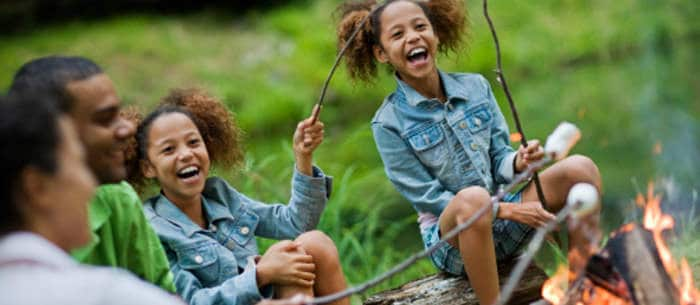Planning a family camping trip? If you’re new to the camping experience (or have never brought kids along before), here is some important advice, fun activities and easy food ideas to get you started.
Jennifer Aist, a parent, educator, instructor and author of “Babes in the Woods,” and Leon Pantenburg, a wilderness enthusiast who teaches survival techniques, share their tips on heading to the great outdoors with kids.
1. Plan ahead
Both Aist and Pantenburg recommend planning ahead to enjoy the best camping experience possible with your kids. As Aist tells us, “It’s all in the planning. Make sure you have the right gear and plenty of good food.” Pantenburg adds, “Paying attention to the little things means the big things take care of themselves.”
2. Choose a family-friendly campsite
Aist says, “I always start by asking around to other families who have been there. Choose a location that offers some options of activities, such as hiking trails or a lake to play in. Avoid campgrounds near major roads. Smaller campgrounds tend to have less traffic. A quick drive through a campground will tell you a lot about it.”
3. Be mindful of children’s ages
Some parents may think their kids are too young to take camping. Aist says there’s no minimum age limit for taking kids camping. “Babies are probably the easiest to camp with of all,” she reveals. “When camping with toddlers or preschoolers, I recommend bringing along an extra adult or teenager to help watch little ones. With babies, if you are trying to set the tent up and cook dinner, bring along a baby carrier to pack the child.”
4. Plan for rain
Pantenburg says one of the best items to pack with you is a supply of tarps and paracord to create an emergency rain shelter. “I like to pitch a main tarp over the picnic table for a dining and games area and another as a place to sit and read. Some of the best times are under the tarp when it rains and everyone can play a game.”
5. Bring supplies
Bikes, a football, a Frisbee and water guns will provide active fun for kids of all ages. Also, bring favorite board games, a deck or two of playing cards, binoculars and small flashlights for each person. Aist adds, “I usually bring along a hammock to swing in, some sidewalk chalk for car camping and a deck of cards for the tent.”
6. Involve the kids
Aist adds, “It really helps to involve children in camp tasks. They can be a great help to you and it keeps them focused on a job rather than wandering around.” Ask your kids to do age-appropriate chores, like collect rocks to weigh down tent corners or gather sticks for the fire. Be sure to check the campground rules for gathering firewood and share the rules with the kids before they begin. And make sure they know how far away they can go and when they should be back.
7. Use the buddy system
Younger kids should be within eyesight and older kids within earshot. Follow the buddy system and don’t let kids walk in the woods alone. Allow downtime for the kids to entertain themselves. Aist says, “Give the kids a chance to just explore and see what activities they come up with on their own. You may be surprised by their creativity.”
8. Keep it safe
Teach kids safety rules. Kids should never leave their campsite or enter other campsites without a parent’s approval. Provide a whistle for kids to wear around their necks. Older kids can also carry a first aid kit. If they get lost in the woods, teach your kids to find a tree, blow three times on the whistle for help and stay at the tree until they’re found. Repeat three short whistles as needed.
9. Educate
Just staying on the trails may not be enough to keep kids safe in the woods. Teach your kids to identify poisonous plants and be aware of animals. Teach kids to follow the “leave no trace” principles by leaving what they find, respecting wildlife and disposing of trash properly. Teaching your children about nature will help them gain a better understanding and respect for the great outdoors. Consider making a stop at your local book store to learn more about the wildlife.
10. The more, the merrier
Camping is more fun when you bring a friend. If you invite extra kids, try to bring extra adults to help watch them. Aist says, “Bringing another family along will make great memories for everyone.”
11. Bring the 10 essentials
When camping or hiking in the woods, bring along the 10 essentials. This list, originally created in the 1930s, has been updated over the years to be more relevant. Matches, a fire starter, a map, a compass, a flashlight or headlamp, extra food and water, extra clothing, sunglasses and sunscreen, a pocket knife and a first aid kit can help you in most any situation.
12. Learn about ticks
A common danger when you’re camping or even just outdoors is ticks. They can burrow into your skin and cause Lyme disease and other illnesses. Make sure your family knows what a tick looks like and how to remove one. Then check each other for ticks often during the camping trip. Add a TickKey to your first aid kit, a little aluminum gadget removes ticks completely, safely and effectively.
13. Pack treats
Bring along fun camp foods to enjoy on your adventure. S’mores are a favorite for many families. Toast a marshmallow over the fire and sandwich between graham crackers lined with squares of chocolate. Make a simple campfire stew by browning ground beef and adding cans of tomato soup and vegetables. Season to taste and enjoy. Bring fresh fruit and cheese for healthy snacks.
14. Play more
Always remember to relax and have fun. Sometimes parents plan too much. One of the best things about a family camping trip is getting away from everyday life. Aist says to “Plan less, play more.” Tell stories around the campfire, read or play board games by the light of a campfire, gather your chairs together to talk after dark and just enjoy one another’s company in a natural setting.



